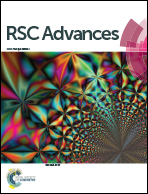Drug release profile and reduction in the in vitro burst release from pectin/HEMA hydrogel nanocomposites crosslinked with titania
Abstract
This work describes the drug release profile and the initial burst release from covalent hydrogel nanocomposites composed of pectin, hydroxyethyl methacrylate (HEMA) and titania (TiO2). Vitamin B12 (Vit-B12), a highly water-soluble substance, was used as a model drug. We studied the water transport profiles over a wide pH range, the moduli of elasticity (E), the morphological properties and the Vit-B12 release kinetics from these hydrogels. The initial release burst was reduced by crosslinking titania with vinylated pectin and HEMA. A reduction of up to ca. 60% was observed when compared with pure pectin/HEMA hydrogel. To gain insight into the burst release phenomenon, the experimental data were adjusted to diffusive-based models that include a rate constant of release (k). A decrease in the values of k was related to a reduction in the burst effect. The release mechanism of Vit-B12 from the pure hydrogels was governed by both Fickian diffusion and macromolecular relaxation, which are the driving forces for release. Upon addition of titania, the contribution of macromolecular relaxation to the release was minimized, suggesting a tendency towards Fickian diffusion. Furthermore, titania played a significant role in improving mechanical properties. Hydrogel nanocomposites showed a marked increase in E compared with pure hydrogels. This increase was found to be the result of an apparent increment in the cross-linking density, owing to chemical bonds of titania with the hydrogel. The proposed materials were demonstrated to be biocompatible with cells, showing good pharmacological potential.


 Please wait while we load your content...
Please wait while we load your content...